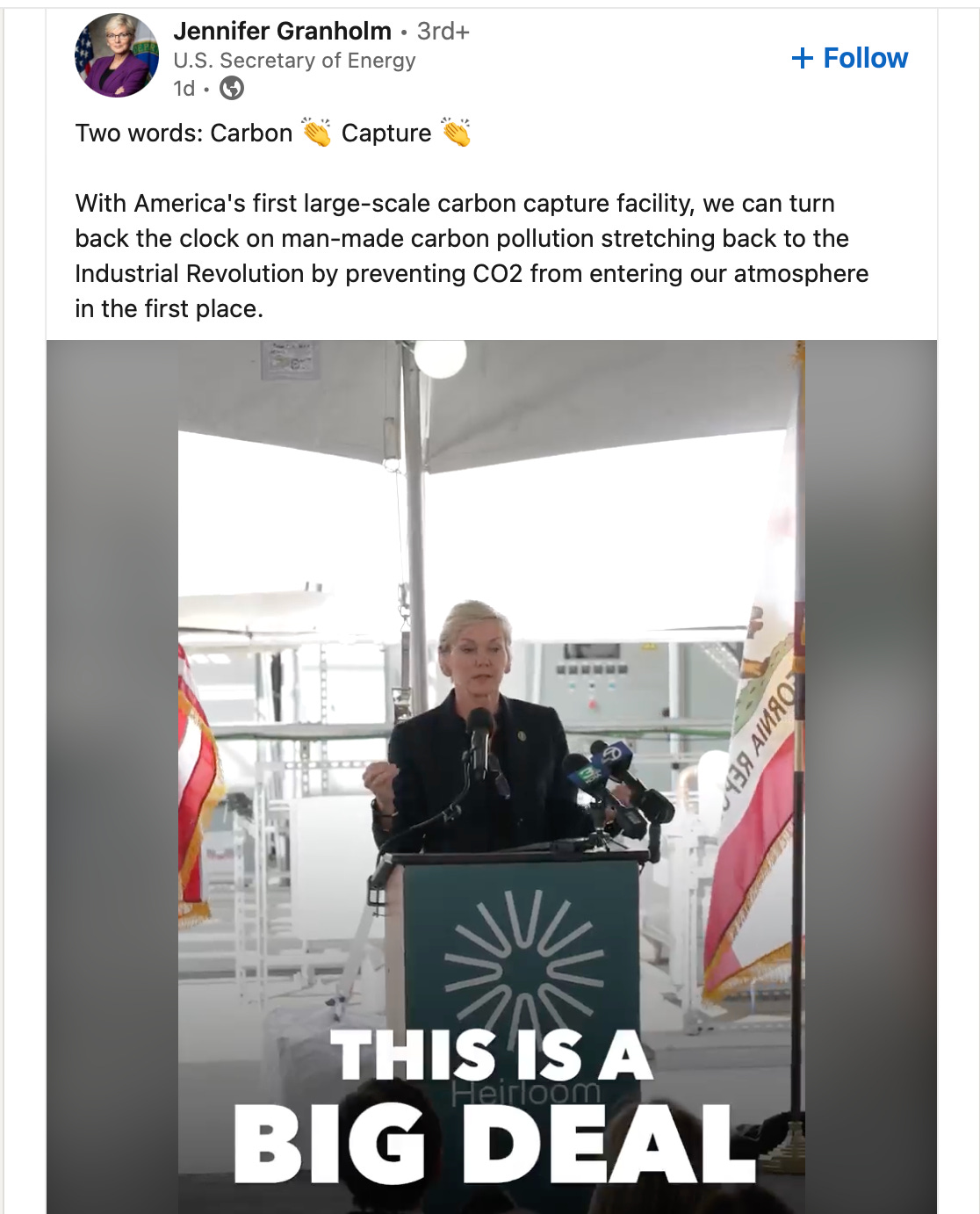Does carbon capture and storage with limestone make sense?
No, it would make more sense just to give everyone an electric car.
US Secretary of Energy recently announced a big investment in Direct Air Capture (DAC) startup Heirloom Carbon, suggesting that its technology can “turn back the clock on man-made carbon pollution.” I have long been skeptical of DAC (I wrote about another technology on Treehugger and in my book) and wondered if this system made any more sense.
Heirloom explains on their website that they “use limestone, one of the world’s most abundant and inexpensive minerals, to capture CO2 directly from the atmosphere, and then permanently and safely store the CO2 underground or in materials like concrete.” The white paper explains in greater detail:
“In the initial step, CaCO3 is sent into a high temperature reactor. Inside this reactor the CaCO3 decomposes into calcium oxide (CaO) and CO2 at temperatures near 900°C at atmospheric conditions.”
Wait a second, I thought, I have written about that process before; they are making non-hydraulic cement, traditionally known as lime mortar. Calcium Carbonate is ground-up limestone, and Calcium Oxide is traditionally known as lime or quicklime.
This is pretty much the process that is responsible for 7% of the world’s carbon emissions, except they don’t add the clay and silicates that would turn it into Portland cement. Heirloom’s cement kiln runs on renewable electricity instead of coal, so the CO2 released is relatively pure and easy to capture. They plan on using it to make zero-carbon concrete and have signed a deal with Canadian X-Prize winner CarbonCure to inject the CO2 into concrete blocks.
They then add water to the calcium oxide to form Ca(OH)2, traditionally known as slaked lime. This hardens by a process of carbonation, absorbing CO2 from the atmosphere in the process and turning it back into Calcium Carbonate. This is called the lime cycle.
No wonder they are called Heirloom; this is a process that our ancestors understood, without the carbon capture.
Recarbonation is a well-known process that the concrete industry uses to claim that concrete isn’t so evil; if you grind up old buildings to increase the surface area of concrete exposed to the atmosphere, the industry suggests that 25% of the CO2 from making concrete can be recaptured some day. It is usually a slow process, but Heirloom grinds up its cement really fine, spreads it out thin in those giant stacks of cookie sheets and claims an 85% recapture in about three days.
It is clever, harnessing an ancient process that uses cheap and common limestone as the source of the absorbent material. Heirloom claims, “We’ve combined the best of engineering and nature, to develop the most affordable and scalable Direct Air Capture technology in the world. We offer the highest quality carbon removal credits available for purchase today.” But does this make any sense?
Let’s follow the process with an example. I feel really bad about driving the Subaru to our cabin 250 km north of Toronto, which, at the Canadian average of 206 grams per km, emits about 50 kg of CO2. I want to offset it with carbon credits from Heirloom.
Cooking a kilo of calcium carbonate generates 440 grams of CO2, so I need 116 kg of it to offset my car. That’s a lotta lime, like four standard 30kg bags of cement for one car trip.
It takes 1.76 megajoules or .488 kilowatt-hours of energy to cook a kilo, so I need a total of 116 *.488= 57kWh of renewable electricity. This is why the cement industry doesn’t use electric kilns; it takes a huge amount of power.
What makes this all so ridiculous is that if I just took that 57 kWh and put it directly into an electric car, which averages 0.2 kWh/km, it would push the car 285 km, past my cottage and all the way to Algonquin Park. This is why Direct Air Capture is so silly; it is vastly cheaper, faster, and more effective to eliminate emissions at the source than it ever will be to try and suck them out of the air.
None of this even counts the upfront carbon for building the Heirloom facility, the handling of many tonnes of lime and thousands of cookie sheets, or any other inefficiencies along the way. The total picture is even sillier.
The US government is investing $600 million in various Direct Air Capture schemes to “turn back the clock” on carbon emissions. A much more effective and immediate reduction in emissions would happen if they just bought 20,000 electric cars and gave them away.
UPDATE: I just read energy expert Michael Barnard’s take on this, where he notes that “Heirloom’s 1,000 tons per year are a pimple on the invisible dot of the total global market for CO2 today.” I am sorry, Secretary Granholm, this is not a big deal; it is a drop in a very big bucket.






Thanks for this. I heard about Heirloom on NPR's How I Built This on March 9 and thought it sounded like total nonsense. Use limestone to make limestone. I even sat down and sketched out my version of your lime cycle resembling a perpetual motion machine.
Carbon capture is a ridiculous concept. The expenditure far outweighs any benefit, when you look at all of the components, which they never do. Their simplified calculations are the scam.